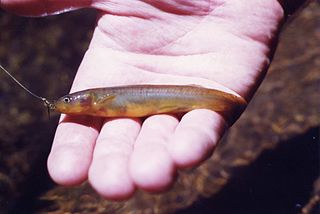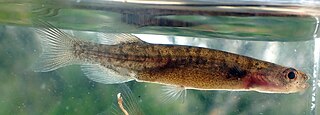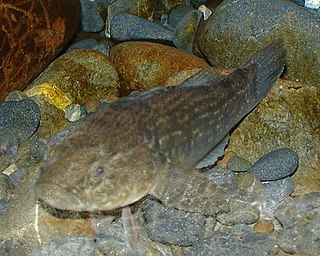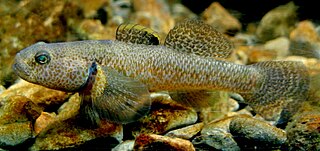
The Galaxiidae are a family of mostly small freshwater fish in the Southern Hemisphere. The majority live in Southern Australia or New Zealand, but some are found in South Africa, southern South America, Lord Howe Island, New Caledonia, and the Falkland Islands. One galaxiid species, the common galaxias, is probably the most widely naturally distributed freshwater fish in the Southern Hemisphere. They are coolwater species, found in temperate latitudes, with only one species known from subtropical habitats. Many specialise in living in cold, high-altitude upland rivers, streams, and lakes.

The black flounder, also known by the Māori language name mohoao, is a flatfish of the genus Rhombosolea, found around New Zealand in shallow enclosed waters and coastal freshwater lakes. Its adult length ranges from 20 to 45 cm.

The Chatham mudfish, formerly known as the Chathams galaxias, is a galaxiid fish endemic to two small, peaty lakes in southern Chatham Island, New Zealand.

The Canterbury mudfish, also known as the kowaro, is found only on the Canterbury Plains in New Zealand. Like other Neochanna species, it is a small, tubular and flexible fish which lacks scales. They are able to survive out of water in damp refuges if its wetland habitat dries out periodically over summer.

The brown mudfish is a galaxiid endemic to New Zealand. The species is found in wetlands in the southwest of the North Island and the northern half of the west coast of the South Island. It commonly grows to 100–130 mm in length, and it can live to at least 7 years. They are named for their brown color.

Neochanna is a genus of galaxiid fishes, commonly known as mudfish, which are native to New Zealand and south-eastern Australia.

The Tasmanian mudfish, Neochanna cleaveri, is a small Australian amphidromous fish in the galaxiid family, of the order Osmeriformes.

The banded kōkopu is a galaxiid of the genus Galaxias, found only in New Zealand, including the Chatham and Stewart/Rakiura islands. It commonly grows to 20–25 cm, but has been recorded growing to around 30 cm. Juvenile banded kōkopu are good climbers and can climb up waterfalls and other vertical surfaces by moving into the splash zone and wriggling up the surface, using the water surface tension and their large downturned fins for grip.

The giant kōkopu is a threatened species of ray-finned fish in the genus Galaxias, found only in New Zealand. It can reach up to 58 cm (23 in) in length and 2.7 kg (6.0 lb) in weight, making it the largest species in the family Galaxiidae. It is a mainly lowland species, commonly found in slow-flowing streams, wetlands, lakes, and lagoons. Most populations have an amphidromous life cycle, with larvae going to sea soon after hatching and returning about four months later as small juveniles, 4.5–5 cm (1.8–2.0 in). Juvenile giant kōkopu form a small part of the annual whitebait catch.

The dwarf inanga is a galaxiid of the genus Galaxias, found in the North Island of New Zealand.

The lowland longjaw galaxias is a galaxiid of the genus Galaxias, found only in the South Island of New Zealand, in the Kauru River, a tributary of the Kakanui River in north Otago, and in parts of the upper Waitaki catchment. It grows to a length of up to 7 cm.

Eldon's galaxias is an endangered galaxiid fish endemic to New Zealand. One of several fishes in the genus Galaxias found in Central Otago, it has a very small home range and is at risk of being driven to extinction by trout introduced for recreational fishing.

The common river galaxias or Canterbury galaxias is a galaxiid fish of the genus Galaxias, found only in Canterbury, New Zealand.
Gollum galaxias is a galaxiid of the genus Galaxias, found only in southern temperate regions in New Zealand. The species is widespread in rivers throughout the Southland Plains as well as the Von River and Nevis River tributaries of the Clutha River The species is found on Stewart Island/Rakiura, and throughout the Catlins.

The New Zealand grayling is an extinct species of fish that was endemic to New Zealand. It was known to the Māori by many names, including pokororo, paneroro, kanae-kura, and most commonly, upokororo. The variety of names for the fish came from either multiple iwi, or to describe the fish at different periods of its life cycle. Even though this fish is named grayling, it is not related to European or American graylings and lacks the large dorsal fin ‘typical’ graylings are characterised by. It is, however, closely related to the Australian grayling. The New Zealand grayling was an amphidromous species, migrating between freshwater and saltwater during different seasons as well as stages in their life cycle. The last sighting of the New Zealand grayling was in 1923, and it was declared extinct in 2018.

The giant bully, tītarakura, or tīpokopoko (Māori), is a species of fish in the family Eleotridae endemic to New Zealand.

The upland bully is a species of fish in the family Eleotridae endemic to freshwater habitats in New Zealand. Both sexes have distinctive orange-brown dots all over the head. Adults generally reach a length of 8–10 cm (3.1–3.9 in).

The redfin bully is a species of freshwater fish in the family Eleotridae endemic to New Zealand. Being amphidromous, it spends part of its life cycle at sea. Males have distinctive bright red patterns and stripes on their fins. Adults grow to an average of 80–100 mm (3.1–3.9 in) total length, with a maximum of 120 mm (4.7 in).

Gerald Stokell was a New Zealand amateur ichthyologist.

The Whangamarino Wetland in the Waikato District is the second largest wetland complex of the North Island of New Zealand. Encompassing a total area of more than 7200 hectares, the Department of Conservation Te Papa Atawhai manages 5,923 hectares of peat bog, swamp, mesotrophic lags, open water and river systems listed as a wetland of international importance under the Ramsar Convention. Fish and Game New Zealand are the second largest landowner, managing 748 hectares of the wetland primarily as gamebird hunting habitat.




















